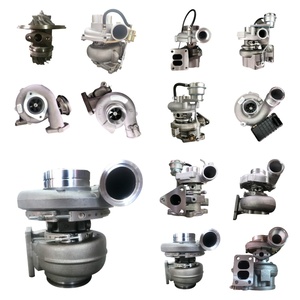(213 products available)
























































































































































































There are different types of Garrett turbochargers for the aftermarket turbocharger market, and they include:
Single turbo
Single-turbochargers are the most common type of turbo found in aftermarket turbocharger kits. As the name implies, every single engine cylinder has one turbocharger. This allows for an even distribution of boost pressure and airflow to all cylinders. Typically, single-turbochargers are more affordable and easier to maintain compared to other turbo types. They are also more versatile and can be used on almost any engine configuration. However, single-turbochargers have their drawbacks. For instance, they may experience turbo lag, which is a delay in boost response, especially at low engine speeds.
Twin-turbochargers
Like single-turbochargers, twin-turbos are exactly what they sound like: two turbochargers in a single engine. However, every two turbochargers work in tandem to service the cylinders. In a V6 or V8 engine configuration, each set of turbochargers powers a bank of cylinders. The primary advantage of twin-turbos is their ability to eliminate turbo lag. They also offer a more linear power delivery. The drawback is that they are more complex and expensive to install and maintain.
Twin-scroll turbochargers
These turbos are a single turbocharger that combines the benefits of both single and twin-turbochargers. Typically, twin-scroll turbochargers have two inlet ports and one outlet port. Each of the two inlet ports collects exhaust gases from different sets of cylinders. This arrangement helps to improve the efficiency of the turbo by reducing the amount of exhaust gas pulsation that reaches the turbine. As a result, twin-scroll turbos can spool up faster and provide more boost pressure across a wider range of engine speeds.
Variable-geometry turbocharger (VGT)
VGTs are primarily used in diesel engines. The turbine blades' angle in a VGT can be adjusted to optimize airflow through the turbocharger at various engine speeds. By improving the airflow through the turbo, the VGT can generate boost pressure more quickly, which in turn reduces turbo lag. However, VGTs are more complex and require additional components, such as an actuator and control system, making them more expensive than fixed-geometry turbochargers.
Garrett turbochargers have a wide range of specifications that cater to different applications. Here are some of the key specifications:
Compressor
For Garrett turbochargers, the compressor is one of the most essential parts. It is in charge of drawing in air and forcing it into the engine. The compressor has several specs that set it apart. The compressor has a compressor wheel diameter that ranges from 33 to 110 mm. Also, there is a compressor A/R (aspect ratio) that ranges from 0.3 to 1.5.
Turbine
Similar to the compressor, the turbine also has specifications that set it apart. The turbine is responsible for drawing in exhaust fumes from the engine and utilizing them to spin the turbine wheel. The turbine also has several specifications that set it apart. The turbine has a turbine wheel diameter that ranges from 31 to 90 mm. In addition, the turbine boasts of a turbine A/R (aspect ratio) that ranges from 0.3 to 1.2.
Turbocharger housing
The turbocharger housing is another critical component that makes the Garrett turbocharger stand out. The housing contains the turbine and compressor and acts as the turbocharger's structure. The housing has several specifications, including a housing A/R (aspect ratio) that ranges from 0.5 to 2.0 and a turbine inlet and outlet diameter that ranges from 20 to 50 mm.
Bearing system
The Garrett turbocharger bearing system is in charge of supporting the turbocharger and reducing friction. The bearing system has several specifications, including bearing material (copper, aluminum, or bronze) and bearing clearance (0.002 to 0.005 mm).
Actuator
The actuator controls the variable geometry (VG) vanes in the turbine and is responsible for adjusting the boost pressure. The actuator has several specifications, including spring force (5 to 20 N) and actuator stroke (3 to 6 mm).
Here are some maintenance requirements for Garrett turbochargers:
Wholesalers should consider the following factors when choosing Garrett turbochargers.
Engine Compatibility
Garrett turbochargers are designed for various engines. The turbocharger needs to be compatible with the engine's size and specifications for proper performance.
Application Type
Different types of applications require different types of turbochargers. For instance, high-performance cars for racing need a turbocharger that can deliver a lot of power, while a casual driving car needs a turbocharger that offers decent power without much lag.
Quality and Authenticity
Ensure the turbocharger is sourced from an authorized and certified Garrett supplier. This guarantees quality and reliability.
Warranty and Support
Consider the warranty period and the availability of technical support. A longer warranty and reliable support are essential in case of any issues.
Budget
Garrett turbochargers come in various price ranges. Wholesalers should choose a turbocharger that fits their budget while meeting the required specifications.
Upgrade Potential
If future upgrades are considered, choose a turbocharger that can be upgraded easily to accommodate future needs.
Installation Requirements
Some turbochargers have more complex installation requirements than others. Consider the time and cost of installing the turbocharger.
Replacing a turbo can be a challenging task, but it is possible to do it as a DIY project. With proper planning and research, the following steps will guide any turbocharged vehicle owner through the replacement process:
Preparation
Read the service manual to understand the steps involved in replacing the turbo for a specific vehicle model. Get the right tools that will be needed for the replacement process. Ensure that the new turbocharger is compatible with the vehicle's engine and exhaust system.
Disconnecting the Battery
To prevent any electrical issues or short circuits, disconnect the battery before starting the turbo replacement process.
Drain Fluids
Drain the engine oil and the coolant before starting the replacement process. This will prevent any oil or coolant spills that could cause accidents or damage to the new turbocharger.
Remove the Old Turbocharger
First, remove any components obstructing the turbo, such as the intake pipe, exhaust downpipe, and oil feed and return lines. Then, disconnect the wastegate actuator and vacuum lines. Next, remove the turbo bolts and nuts, then, disconnect the turbo from the exhaust manifold. Finally, remove the old turbo from the exhaust and intake systems.
Install the New Turbocharger
First, align the new turbocharger with the exhaust manifold and intake system, then, connect it to the manifold using bolts and nuts. After that, connect the oil feed line to the turbo and ensure it is properly fitted without any leaks. Then, connect the oil return line and ensure it is properly fitted without any leaks. Finally, connect the wastegate actuator and vacuum lines to the new turbocharger.
Reassemble and Reconnect
Put back all the components that were removed earlier, such as the exhaust downpipe, intake pipe, and any other obstructing components. Then, reconnect the battery and ensure all electrical connections are properly fitted. After reassembling and reconnecting all components, refill the engine oil and coolant.
Start the Engine and Check for Leaks
Start the engine and let it run for a few minutes. Then, check for any oil or coolant leaks around the turbo and its associated lines. If there are any leaks, ensure to fix them before driving the vehicle.
Q1: Are dual turbochargers better than single ones?
A1: Single turbochargers work well for most drivers. They are also more affordable and less complex than dual turbochargers. However, the latter can generate more power and perform better.
Q2: What is the difference between a turbocharger and a supercharger?
A2: While turbochargers use exhaust air to spin a turbine and force more air into the engine, superchargers use the engine's power to run an air pump that sends more air into the engine.
Q3: How long do turbochargers last?
A3: Typically, a turbocharger can last between 100,000 and 200,000 miles. Proper maintenance and driving habits can help it last longer.
The keyword "garrett turbocharger sale" has maintained a consistent web search volume trend over the past year, with an average monthly search count of 10. The data shows no significant change in interest, with both the three-month and one-year change registering at 0%. Over the 12-month period, the web search volume remained steady, with the exception of September 2024, where web searches dropped to 0.
Analyzing the monthly search data for "garrett turbocharger sale," we observe a stable pattern with minor fluctuations. The web search volume consistently hits 10 web searches per month, except for September 2024, when it unexpectedly dipped to zero. This could suggest a seasonal variation or an external factor influencing the search behavior temporarily. The consistent web search volume throughout other months indicates a steady interest in this product, likely driven by ongoing demand in the vehicle parts and accessories market.
The lack of significant change in web search volume over the year suggests that the market for Garrett turbochargers is relatively stable. The product appears to have a dedicated niche audience who search for it consistently without major spikes or drops in interest. This stability could be attributed to the product's reliability and popularity among vehicle enthusiasts and mechanics who require durable and efficient vehicle parts. The sudden absence of web searches in September could be an anomaly or could indicate a temporary market shift or external event affecting search behavior, which would require further investigation for a complete understanding.